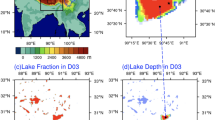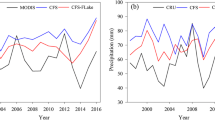Abstract
A one-dimensional (1-D) physically based lake model was coupled to the Weather Research and Forecasting (WRF) model version 3.2 developed by the National Center for Atmospheric Research to dynamically simulate physical processes of lakes and their effects on weather and climate at local and regional scales. Our study area is focused on the Great Lakes. This coupled model realistically reproduces the lake surface temperature (LST) at a buoy station in a shallow lake (Lake Erie) while generating strong LST biases ranging from −20 to 20 °C at a buoy station in a deep lake (Lake Superior). Through many sensitivity tests, we find that the biases in the deep lake LST simulations result from the drastic underestimation of heat transfer between the lower and upper parts of the lake through unrealistic eddy diffusion. Additional tests were made to calibrate the eddy diffusivity in WRF-Lake. It is found that when this parameter is multiplied by a factor ranging from 102 to 105 for various lake depths deeper than 15 m, the LST simulations for the deep lake buoy station show good agreement with observations, and the bias range reduces to ±4 °C. Essentially, the enlarged eddy diffusivity strengthens heat transfer within the lake columns in the deep lake, which is significantly underestimated in the lake model without calibration. Validation simulations with the calibrated eddy diffusivity were carried out for the whole of Lake Superior and Lake Erie. The LST simulations still have a substantial bias reduction when compared with those produced with the original eddy diffusivity, indicating that the calibrated parameter is representative. In addition, the improved 1-D lake model with WRF reasonably reproduces the remotely sensed LST geographic distribution.







Similar content being viewed by others
References
Bates GT, Giorgi F, Hostetler SW (1993) Toward the simulation of the effects of the Great Lakes on regional climate. Mon Weather Rev 121:1373–1387
Bonan GB (1995) Sensitivity of a GCM simulation to inclusion of inland water surfaces. J Clim 8:2691–2704
Boyce FM, Hamblin PF, Harvey LD, Schertzer WM, McCrimmon RC (1993) Response of the thermal structure of Lake Ontario to deep cooling water withdrawals and to global warming. J Gt Lakes Res 19:603–616
Braham RR, Dungey MJ (1984) Quantitative estimates of the effect of Lake Michigan on snowfall. J Appl Meteorol 23:940–949
Csanady GT (1964) Turbulence and diffusion in the Great Lakes. Mich Univ Gt Lakes Res 11:326–339
Csanady GT (1966) Dispersal of foreign matter by the currents and eddies of the Great Lakes. Mich Univ Gt Lakes Res 15:283–294
Dudhia J (1989) Numerical study of convection observed during the winter monsoon experiment using a mesoscale two-dimensional model. J Atmos Sci 46:3077–3107
Eichenlaub VL (1979) Weather and climate of the Great Lakes region. University of Notre Dame Press ISBN:0268019290
Goyette S, McFarlane NA, Flato GM (2000) Application of the canadian regional climate model to the Laurentian Great Lakes region: implementation of a lake model. Atmos-Ocean 38:481–503
Henderson-Sellers B (1985) New formulation of eddy diffusion thermocline models. Appl Math Modelling 9:441–446
Henderson-Sellers B, Davies AM (1989) Thermal stratification modeling for oceans and lakes. Ann Rev Numer Fluid Mech Heat Transf 2:86–156
Henderson-Sellers B, McCormick MJ, Scavia D (1983) A comparison of the formulation for eddy diffusion in two one-dimensional stratification models. Appl Math Mod 7:212–215
Holroyd EW (1971) Lake-effect cloud bands as seen from weather satellites. J Atmos Sci 28:1165–1170
Hong SY, Pan HL (1996) Nonlocal boundary layer vertical diffusion in a medium-range forecast model. Mon Weather Rev 124:2322–2339
Hostetler SW (1993) Interactive coupling of a lake thermal model with a regional climate model. J Geophys Res 98:5045–5057
Hostetler SW, Giorgi F et al (1994) Lake-atmosphere feedbacks associated with Paleolakes Bonneville and Lahontan. Sci 263(5147):665
Kain JS, Fritsch JM (1993) Convective parameterization for mesoscale models: the Kain-Fritsch scheme. The representation of cumulus convection in numerical models, Meteor Monogr, No. 46, Amer Meteor Soc 165–170
Kourzeneva E (2010) External data for lake parameterization in numerical weather prediction and climate modeling. Boreal Env Res 15:165–177
Lavoie RL (1972) A mesoscale model of lake effect snowstorms. J Atmos Sci 29:1025–1040
Leon LF, Lam DCL, Schertzer WM, Swayne DA, Imberger J (2007) Towards coupling a 3-D hydrodynamic lake model with the Canadian regional climate model: simulation on Great Slave Lake. Environ Model Softw 22:787–796
Lin YL, Farley RD, Orville HD (1983) Bulk parameterization of the snow field in a cloud model. J Clim Appl Meteorol 22:1065–1092
Ljungemyr P, Gustafsson N, Omstedt A (1996) Parameterization of lake thermodynamics in a high-resolution weather forecasting model. Tellus A 48:608–621
Martynov A, Sushama L, Laprise R (2010) Simulation of temperate freezing lakes by one-dimensional lake models: performance assessment for interactive coupling with regional climate models. Boreal Env Res 15:143–164
Mironov D, Rontu L et al (2010) Towards improved representation of lakes in numerical weather prediction and climate models: introduction to the special issue of Boreal Environment Research. Boreal Env Res 15:97–99
Mlawer EJ, Clough SA (1997) On the extension of RRTM to the shortwave region. In: Proceedings of the Sixth Atmospheric Measurement (ARM) Science Team Meeting, CONF-9603149. US Department of Energy, Washington, pp 223–226
Niziol TA, Snyder WR, Waldstreicher JS (1995) Winter weather forecasting throughout the eastern United States. IV: lake effect snow. Weather Forecast 10:61–77
Notaro M, Zarrin A, Vavrus S, Bennington V (2013) Simulation of heavy lake-effect snowstorms across the Great Lakes basin by RegCM4: Synoptic climatology and variability. Mon Wea Rev (in press).
Oleson KW, Dai Y, Bonan G et al (2004) Technical description of the community land model (CLM). NCAR/TN-461 + STR, 174 p
Peeters F, Livingstone DM, Goudsmit GH, Kipfer R, Forster R (2002) Modeling 50 years of historical temperature profiles in a large central European lake. Limnol Oceanogr 47:186–197
Rouse WR, Oswald CJ, Binyamin J et al (2005) The role of northern lakes in a regional energy balance. J Hydrometeorol 6:291–305
Samuelsson P, Kourzeneva E, Mironov D (2010) The impact of lakes on the European climate as simulated by a regional climate model. Boreal Env Res 15:113–129
Schmidlin TW, Kosarik J (1999) A record Ohio snowfall during 9–14 November 1996. Bull Am Meteorol Soc 80:1107–1116
Scott RW, Huff FA (1996) Impacts of the Great Lakes on regional climate conditions. J Gt Lakes Res 22:845–863
Stepanenko VM, Goyette S, Martynov A, Perroud M, Fang X, Mironov D (2010) First steps of a lake model intercomparison project: lakeMIP. Boreal Env Res 15:191–202
Subin ZM, Riley WJ, Mironov D (2012) An improved lake model for climate simulations: model structure, evaluation, and sensitivity analyses in CESM1. J Adv Model Earth Syst 4, M02001
Swayne D, Lam D, MacKay M, Rouse W, Schertzer W (2005) Assessment of the interaction between the Canadian Regional Climate Model and lake thermal–hydrodynamic models. Environ Model Softw 20:1505–1513
Sweers HE (1970) Vertical diffusivity coefficient in a thermocline. Limnol Oceanogr 15:273–280
Tsuang BJ, Tu CY, Arpe K (2001) Lake parameterization for climate models. Report No. 316, Max Planck Institute for Meteorology, 72 p
Vavrus S, Notaro M, Zarrin A (2013) The role of ice cover in heavy lake-effect snowstorms over the Great Lakes basin as simulated by RegCM4. Mon Weather Rev 141:148–165
Wright DM, Posselt DJ, Steiner AL (2013) Sensitivity of lake-effect snowfall to lake ice cover and temperature in the Great Lakes region. Mon Weather Rev 141:670–689
Yeates PS, Imberger J (2003) Pseudo two-dimensional simulations of internal and boundary fluxes in stratified lakes and reservoirs. Inter J River Basin Manag 1:297–319
Zeng X, Shaikh M, Dai Y, Dickinson RE, Myneni R (2002) Coupling of the common land model to the NCAR community climate model. J Clim 15:1832–1854
Acknowledgments
This work was supported by the Utah Agricultural Experiment Station, the NOAA MAPP NA090AR4310195 grant, and the EPA RD83418601 grant.
Author information
Authors and Affiliations
Corresponding author
Additional information
This article is part of a Special Issue on “Regional Earth System Modeling” edited by Zong-Liang Yang and Congbin Fu.
Rights and permissions
About this article
Cite this article
Gu, H., Jin, J., Wu, Y. et al. Calibration and validation of lake surface temperature simulations with the coupled WRF-lake model. Climatic Change 129, 471–483 (2015). https://doi.org/10.1007/s10584-013-0978-y
Received:
Accepted:
Published:
Issue Date:
DOI: https://doi.org/10.1007/s10584-013-0978-y




